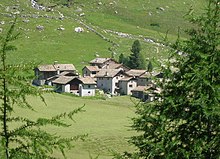Fextal
The Fextal ( Rhaeto-Romanic ) is a side valley of the Upper Engadine in the Swiss canton of Graubünden . Politically it is part of the municipality of Sils in Engadin / Segl .
geography
The valley is one of the highest valleys in Switzerland that are inhabited all year round. Starting from Sils Maria ( 1809 m above sea level ) at the end of the valley there are the small settlements Vaüglia , Platta , Crasta (1951 m), Vals and Curtins (1973 m), which mostly consist of only a few houses.
The high valley begins on the Fexer Glacier , which is surrounded by a ring of mountain peaks such as Il Chapütschin , La Maonigia , Piz Fora , Piz Güz and the 3,441 m high Piz Tremoggia (trident). This is also the source of the Fedacla , which flows through the valley and which used to devastate Sils with large amounts of water.
The Fex Valley, cleared in the shape of a trough by the glacier, flows as a hanging valley with a stepped terrain into the Upper Engadin, about a hundred meters below.
history
Probably used as pasture since the 12th century, the valley was mentioned in 1303 as Fedes (from Feda , " sheep "). Since 1538 it belonged to the neighborhood (municipality) Sils.
For around three hundred years, mica slabs were mined in the rear of the Fex Valley for the construction of stoves and to cover house roofs, the so-called Fexer panels . After 1964 the facilities fell into disrepair. In autumn 2017, the house of the former quarry workers was refurbished and there are guided tours on the history of the quarry.
In 2000 the Fex valley had 101 inhabitants. There are two hotels, some guest houses and three full-time and two part-time farmers here. Since 1954 the entire valley has been under strict nature protection , private motor vehicle traffic is only allowed to the few residents. Tourists can use horse-drawn carriages or, in winter, horse-drawn sleighs for goods and passenger transport.
Picturesque for tourists today, the valley used to be the starting point for small smugglers over the mountains to and from Italy.
Attractions
The little mountain church in Fex-Crasta , built around 1500, contains frescoes by an unknown Northern Italian master from 1511. The urn of the conductor Claudio Abbado is buried in the cemetery.
literature
- Flurin Camenisch, Alfred Schneider: Val Fex: View into a quiet valley . Haupt, Bern 2001, ISBN 3-258-05909-8 (= Swiss homeland books , volume 38).
- Oswald Wyss, Constant Wieser, Alfred Wyss: Bergkirche Fex-Crasta , GSK, Basel 1977 (without ISBN, = Swiss Art Guide, Volume 202).
- Ludmila Seifert-Uherkovich; Regina Bühlmann (editor): The mountain church of Fex-Crasta . GSK, Bern 2009, ISBN 978-3-85782-843-0 (= Swiss Art Guide , number 843, series 85).
- Constant Wieser: Val Fex: The valley, the houses and their inhabitants . 2nd, improved edition. Pro Fex 2007.
Web links
- Ottavio Clavuot: Fex. In: Historical Lexicon of Switzerland .
- Described the hike through the Fex with lots of photos and information on history and geology
- Pro Fex, Association of Friends of the Fex Valley
Individual evidence
- ↑ Cheva Plattas da Fex Foundation. Accessed August 21, 2020 .
- ↑ Claudio Abbado has returned to his place of inspiration. www.suedostschweiz.ch, November 19, 2014, accessed on August 29, 2017 .




